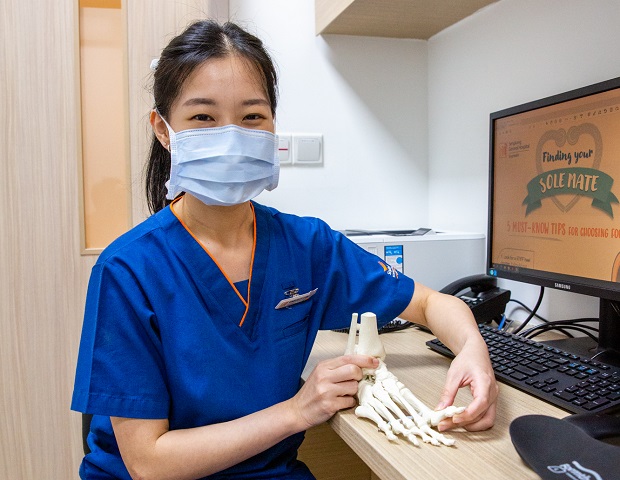COVID-19 pandemic reveals that sedentary lifestyles lead to more foot problems
Even as Singapore moves towards living with endemic COVID-19, the problems resulting from the pandemic are still being experienced by many. One such concern is the sedentary lifestyle adopted by many in Singapore during the pandemic.
Podiatrists in Sengkang General Hospital (SKH) are seeing a surge in the number of patients with foot issues. “The ‘circuit breaker’ caused gyms, workplaces and schools to close temporarily or have restricted capacity. This led to people decreasing their physical activities and having a more sedentary lifestyle,” said Ms Kimberley Leow, Podiatrist, Podiatry Department, SKH.

Engaging in regular physical activity is vital to maintaining foot health, which enables individuals to perform their daily activities optimally.
As individuals stay home for longer periods, they also spend more time walking barefoot. Experts believe that poor foot health is closely associated with the increase in the duration a person spends barefoot.
With the easing of restrictions, individuals keen to return to their exercise regimen may also suffer from injuries when they suddenly increase the amount or intensity of their physical activities.
A study conducted by SKH also revealed that more elderly patients aged between 61 and 80 years sought podiatric treatment after the ‘circuit breaker’ period. Before that, podiatrists treated more patients in their late 40s.
As people age, their feet and ankles undergo physiological changes. For instance, an individual may have reduced joint mobility or lose the fat pads that cushion their soles and heels. These changes affect the way their feet function, said Ms Leow.
Older individuals are not only unable to engage in the same level of activities as they did when they were younger, they are also at a higher risk of developing foot pain.
Common foot conditions
The study also observed that the top three most common foot problems during the pandemic were plantar fasciopathy, corns and calluses, and bunions.
Plantar fasciopathy is a condition where individuals feel pain at the bottom of their heel when they stand after sitting for prolonged periods. The pain also usually occurs when individuals take their first few steps in the morning.
The second most treated condition is corns and calluses. Calluses are thick and rough patches of skin, while corns are smaller and deeper patches of rough skin with a central nucleus or a raised bump.
Bunions are bulging bumps on the inner side of the big toe joint, causing swelling or soreness around the affected toe. A person with bunions may also have corns or calluses on the base of their big toe joint due to the friction caused by rubbing against footwear, or on the first and second toes, where the toes rub against each other.
Read more: Have a flat foot or flat feet? Here’s what you can do to minimise pain.

Caring for your feet
The key to managing foot conditions is to maintain good foot care.
“Good foot hygiene protects the feet from potential sources of infection. Wash the feet and dry the area between the toes thoroughly. Remember to change socks every day, and remove dirt or debris from shoes,” Ms Leow said.
Corns and calluses can be managed by regularly using a foot file, and applying an emollient to affected areas to soften the skin and alleviate foot pain.
It is also important to choose the right footwear. Ms Leow encourages individuals to choose comfortable and properly fitted shoes. A good pair of shoes should leave enough room for the widest part of your foot and the depth of your longest toe.
“When we walk, our feet spread out and expand by up to one centimetre in each direction, so pick a shoe that is longer than your feet by about the width of your thumb,” she added.
Shoes should also provide good heel support, such as a cushioned heel cup that is stable enough to prevent vertical or horizontal heel movement. When trying shoes, ensure that the midsoles do not twist in the middle.
To protect the feet, avoid wearing worn-out shoes as they may lack basic cushioning or support, thus increasing the impact and stress on the legs and joints. Individuals who exercise should also ensure that they stretch properly before their workouts and throughout the day to avert injury and muscle stiffness. Wearing house sandals with good support at home can prevent straining of feet.
Those with persistent foot pain or discomfort can consider seeing a podiatrist for custom foot orthotics. These are medically prescribed devices worn in shoes. Ms Leow explained that orthotics help correct the foot’s alignment, redistributing excess pressure from painful areas evenly across the feet.
Get the latest updates about Singapore Health in your mailbox! Click here to subscribe.
Tags:
;
;
;
;
News Article;
;
Sengkang General Hospital;SingHealth;
;
Singapore Health;
;
;
;
;
Singapore Health
